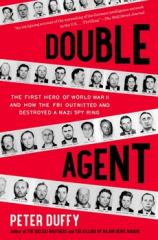Double Agent: The First Hero of World War II and How the FBI Outwitted and Destroyed a Nazi Spy Ring
Review
Double Agent: The First Hero of World War II and How the FBI Outwitted and Destroyed a Nazi Spy Ring
A few days after the bombing of Pearl Harbor, members of a group of American men and women known as the Duquesne Spy Ring were all found guilty of treason against the United States. Behind this large, well-played game of spycraft ending in multiple lengthy imprisonments was one man who, until relatively recently, was unknown, his real name not revealed, his life story kept a secret due to his activities as a double agent.
"The intrigues of Sebold and his minders, vividly depicted by journalist/author Peter Duffy...read at times like a John le Carré novel. There is a gray, dank sense of boredom in a spy's daily existence, along with a frisson of reckless endangerment, both of which Duffy conveys through a plethora of historical detail."
William Sebold was a German-born naturalized American citizen who took his oath of loyalty to his new country seriously. In the early days of Hitler's rise to power, he returned to Germany to visit his mother and was recruited as a spy for the Nazis. Reckoning that he might not get back to the US if he refused, he allowed himself to be trained in espionage. But he also let his recruitment be known to the Americans and asked to work for the FBI as a counter-espionage agent. For two years, he lived a shadowy, spy-vs-spy existence, befriending the German underground operating in New York City, and its roguish leader, South African Fritz Duquesne, who proudly boasted of having killed Britain's Lord Kitchener. The man charged with supervising the operation to bring down Duquesne, unapologetic master-spy Hermann Lang and their cohort of German sympathizers was J. Edgar Hoover, in his new position as head of the FBI.
The intrigues of Sebold and his minders, vividly depicted by journalist/author Peter Duffy (THE BIELSKI BROTHERS), read at times like a John le Carré novel. There is a gray, dank sense of boredom in a spy's daily existence, along with a frisson of reckless endangerment, both of which Duffy conveys through a plethora of historical detail. An example is the code used by Sebold and his principal American contacts, "based upon the letter arrangements of a particular page (which would change each day) in the British edition of Rachel Field's bestselling historical romance, ALL THIS, AND HEAVEN TOO.
Ironically, the first cause for which the Duquesne Spy Ring was being trailed was the Norden bombsight, a piece of equipment that, it was believed, could make bombing almost completely accurate and efficient; Lang had worked in the Norden plant, and it was believed he leaked its design to the Nazis. But in the heat of the European air war, it turned out that the bombsight was not a major factor, as it was quickly determined that "the best way to defeat Germany was to pummel its cities under the cover of darkness."
Nonetheless, the Ring's members were bent on a perfidious quest to foster Germany's domination of the world and the elimination of Jews and other inferiors, as well as anyone inimical to the German cause. Sebold, a quiet man of accurate mind and unusual patriotism, unhesitatingly did his part to see that they did not succeed.
Reviewed by Barbara Bamberger Scott on July 25, 2014
Double Agent: The First Hero of World War II and How the FBI Outwitted and Destroyed a Nazi Spy Ring
- Publication Date: July 7, 2015
- Genres: History, Military, Nonfiction
- Paperback: 352 pages
- Publisher: Scribner
- ISBN-10: 1451667965
- ISBN-13: 9781451667967











